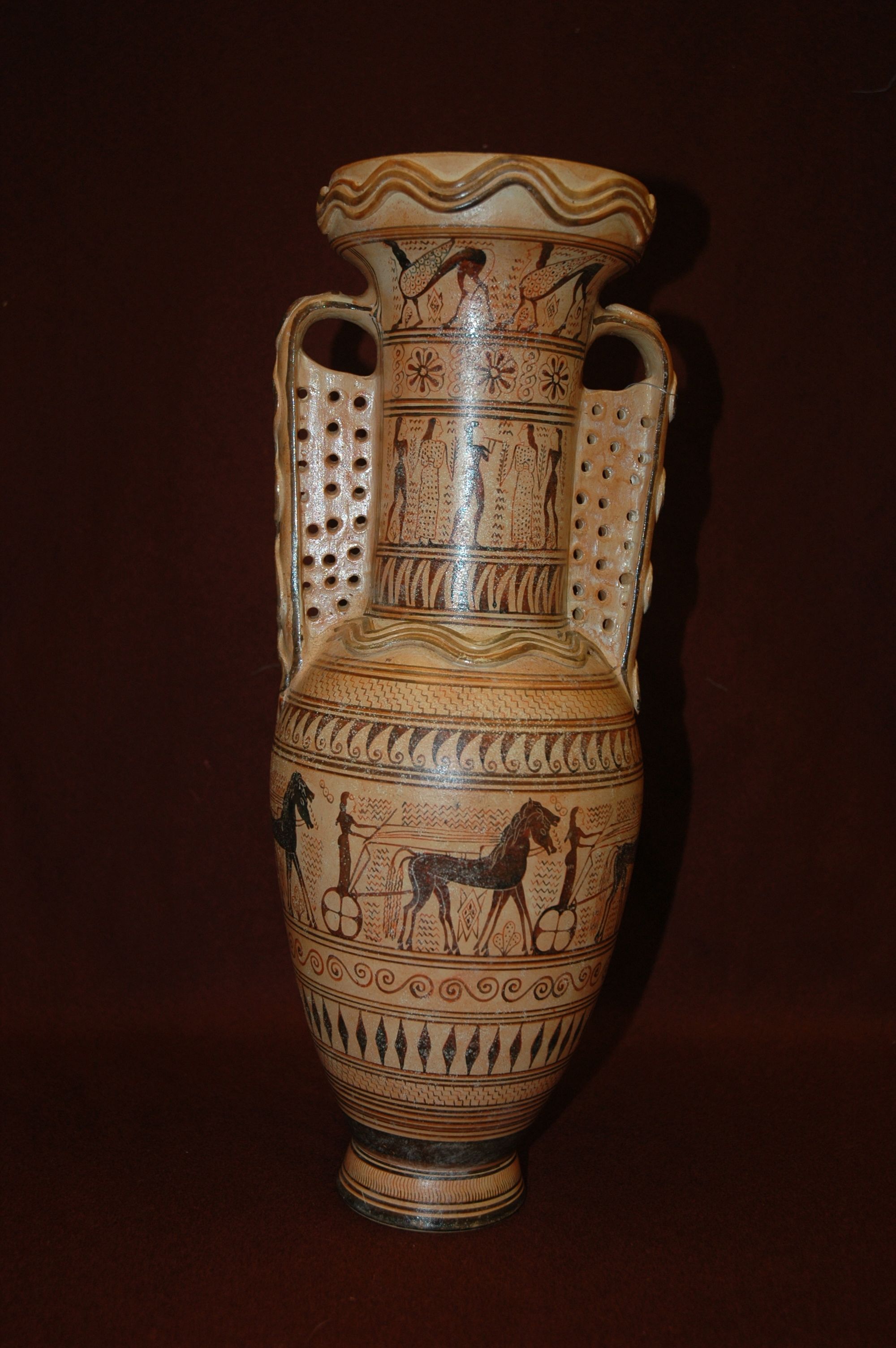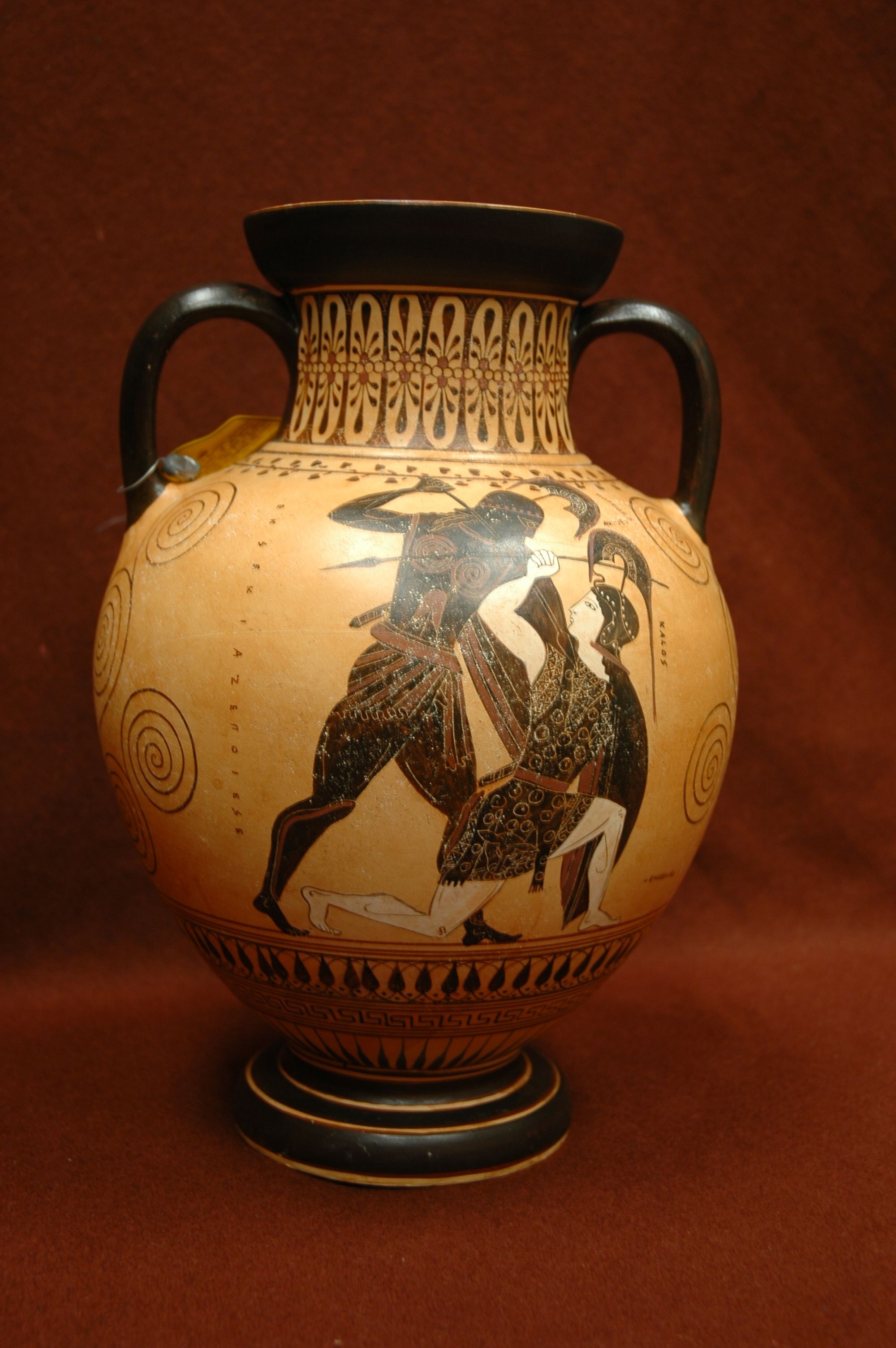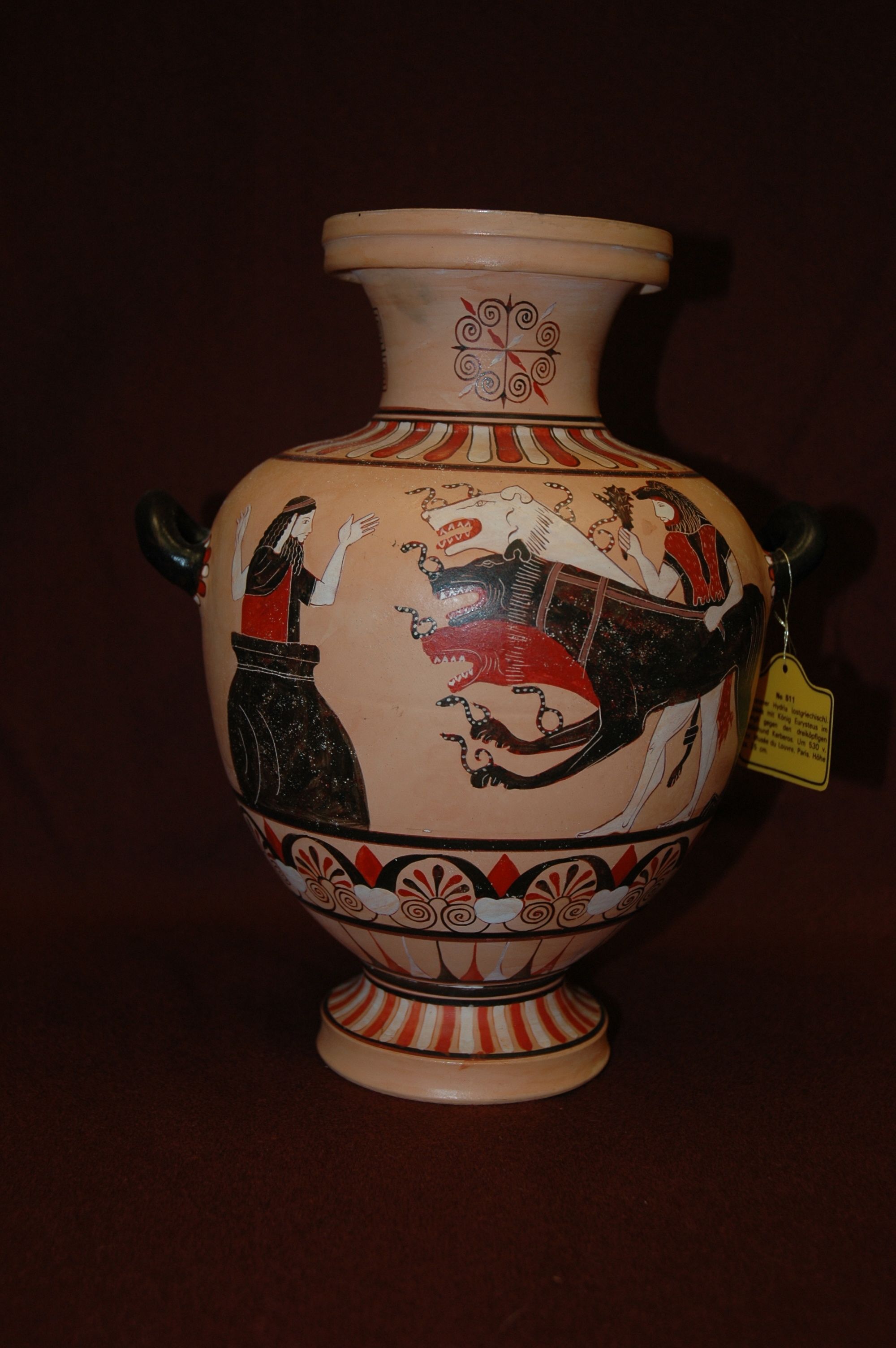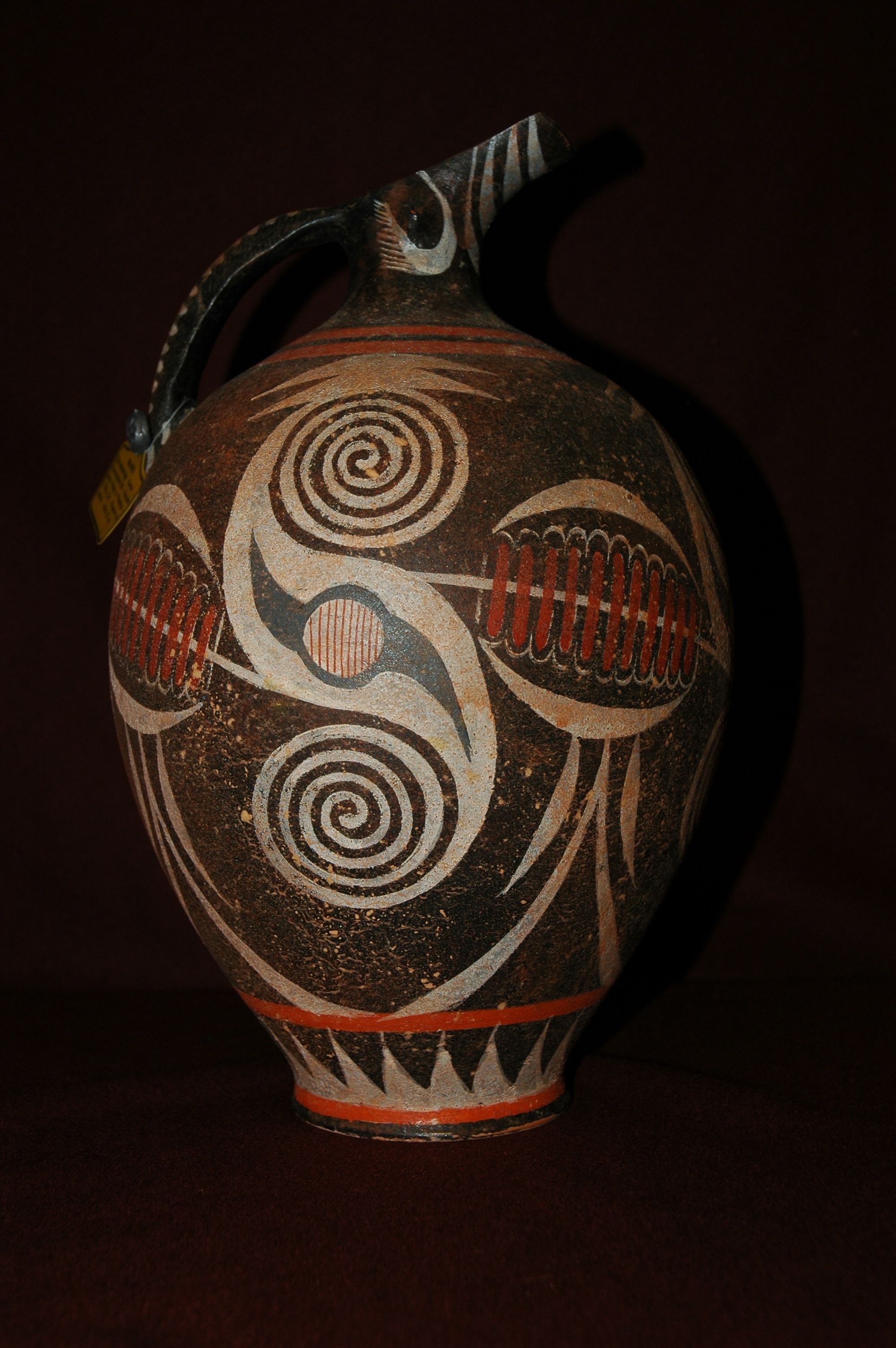Replica Greek Vase Collection
The Department of Classical Studies is fortunate to have a small collection of replica Greek vases. The collection is currently displayed on the second floor of Harrison Hall. Faculty in Classical Studies sometimes use the collection in their courses and students in the department have done special projects with the vases. Below are some highlights from the collection.
Pottery has been called "the curse of archaeology" because it is virtually indestructible and on most archaeological sites, particularly in the ancient Mediterranean, ceramic material can accounts for over 90% of the excavated artifacts. Careful analysis of ceramic material allows archaeologists to date the stratigraphic levels of a site and to draw conclusions about social habits, cooking and eating practices, as well as the economy and trade. Painted pottery from the Greek period also provides information about artistic and technological developments as well as providing some of the best images of Greek mythological narratives.
DePauw students interested in learning more about Greek Art and Culture, and Greek archaeology should consider taking CLST 253 and/or CLST 263.
|
Replica of a Kamares Ware Jug |
Early Greek Pottery: Technology and Elite Trade This painted jug is typical of the Kamares Ware style of pottery, which was produced on Crete during the Bronze Age, ca. 1850 BCE (Middle Minoan IIA period). Kamares ware occurs in a variety of shapes. Some examples, such as the so-called tea cups, have such thin walls that they must have been made using a fast potter's wheel. This is a technological advancement from the handmade pottery of the previous periods on Crete. The polychromatic designs that emphasize the shape of each vessel is also a hallmark of the Kamares style. Kamares ware appears to have been used exclusively be the elite of Middle Bronze Age Crete. Examples of this style have been found only at the palace sites (such as Phaistos, Knossos, and Mallia) and at a few rural sanctuaries sites, the use of which would have been controlled by the palaces. Kamares ware has also been discovered at non-Minoan palace sites in the eastern Mediterranean. This evidence indicates that the pottery was part of the elite trade network operating in the Bronze Age Mediterranean. It also introduces the question of value. Was this pottery valuable as a well-made and decorated work of art, or was it valuable for the contents of the vessels, which could include oils, wine, and perfumes? |

Replica of the Analatos Amphora, Protoattic Period, early 7th century BCE |
Geometric Style and the Birth of Narrative in Greek Art After the end of the Bronze Age (ca. 1200 BCE), many regions of Greece fell into decline. As the Greek city-state began to emerge in the 9th century BCE, potters began to indulge in decorating ceramics once again. This began with simple geometric patterning in the 9th century. As Greek cities increased their trade relations with the rest of the Mediterranean, eastern motifs, such as mythological animals, began to appear in Greek art. The Analatos amphora, produced in Athens in the early 7th century BCE, combines remnants of the Geometric style with eastern motifs, the sphinxes circling the neck, and a new Greek interest in narrative. On the tall neck of the amphora a ritual dance is depicted. Men, shown in black geometric silhouette, alternate with women who are painted with white gowns. The main scene on the body of the amphora depicts a chariot procession. Although these scenes are generic in nature (i.e., there are no specific indicators to identify the participants in the dance or the procession), they would have had narrative meaning for the owners and viewers of the amphora. In this case, the Analatos amphora was likely used as a grave marker. |

Replica Attic Black-Figure Amphora by Exekias depicting Achilles and Penthesilea, ca. 540-530 BCE |
Greek Mythology, Athenian Artists, and the Etruscans By the 6th century BCE, Greek vase painters, particularly those working in Athens, had begun to use references to Greek gods and goddesses as well as Greek heroic narratives in their painting. Perhaps the most famous artist to work in this period was Exekias (550-525 BCE). While previous painters had used the circular nature of most vessels to create extended mythological stories, Exekias preferred to highlight a single scene on the center of the vase. Achilles combat with Amazon Queen Penthesilea is one of the best examples of this technique. Exekias worked in the black-figure style, which relies on the use of an etching tool to render detail and the use of some added color, in this case the white to indicate the flesh of Penthesilea. In this moment, taken from one of the lost epics in the Homeric tradition, Achilles has his spear at Penthesilea's throat. As he is about to kill her, their eyes lock and they fall in love. We know the name of the artist, because Exekias liked to sign his work. To the left of Achilles, one can see the line "Εκσεκιας εποισε" - "Exekias made it" written vertically from the neck down. We know the actual names of only a few Greek painters. Exekias' signature raises the question of his status. Was he a well-respected artist who worked on commission, or a highly-skilled but low-wage craftsman? Further complicating the issue of value in Greek vase painting, is the fact that this vase, like so many others produced in Athens in the 6th century BCE, was actually found in a tomb in the Etruscan city of Vulci (in Italy). The Etruscans, it seems, were quite fond of Greek mythological vase painting and one theory is that most painted pottery produced in Athens was actually made specifically for the Etruscan market. Other scholars have argued that the vases themselves were of very little value and other trade goods (metals, wheat, oil, wine, etc.) were the primary goods traded between the Etruscans and the Greeks. |

Replica Caeretan Hydria depicting Herakles and Cereberus, ca. 530-510 BCE |
Etruscans Imitating Greeks The Etruscans were evidently inspired by Greek decorative pottery and by the end of the 6th century BCE they were beginning to make their own versions. A series of such vases are called Caeretan hydria after the Etruscan city of Caere where they were produced. The artists were either native Etruscans who had learned their craft from Greek artists or Greeks who had come to settle in Etruria. The example in DePauw's collection depicts one of the labors of Herakles. In this case he has returned from the underworld with the three-headed god, Cerberus, and he using the dog to torment Eurystheus, who is attempting to hide in a large jar (a pithos). The Etruscans readily adopted many Greek gods and heroes but they were particularly fond of Herakles, who appears frequently in Etruscan art. The Etruscan style of painting is distinguished for its use of polychromy. In this example the artist employs this to great effect in order to distinguish the three heads of Cerberus. |
